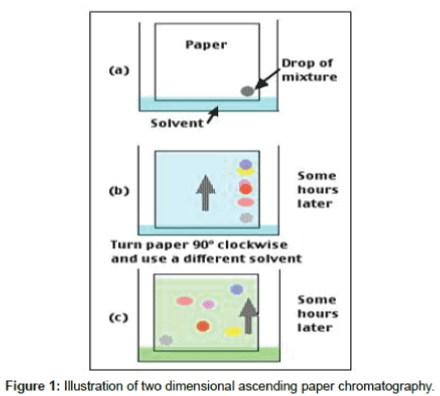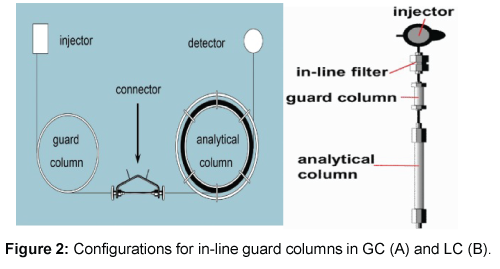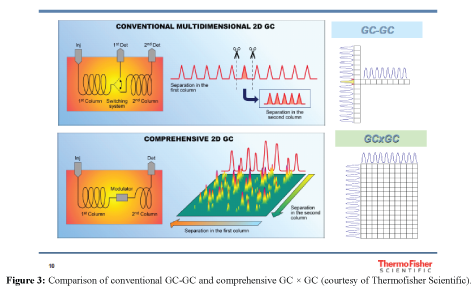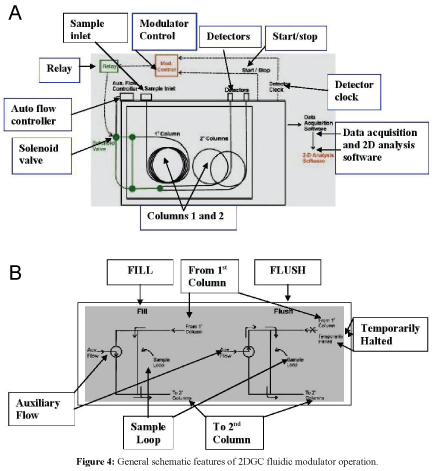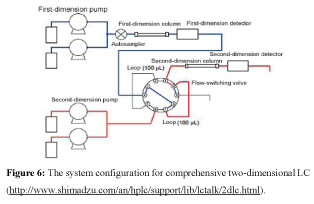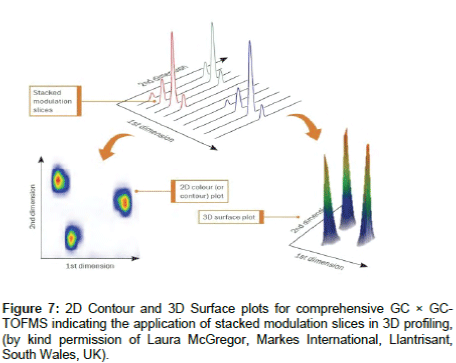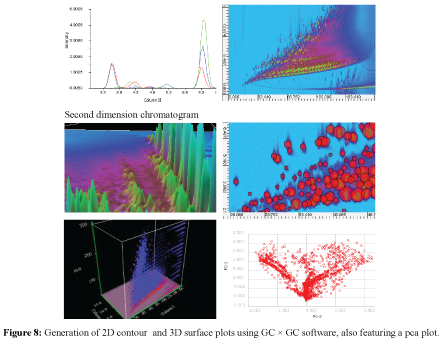Research Article Open Access
Advances and Changes in the Techniques of Multi- Dimensional and Comprehensive Chromatography and When Coupled with Mass Spectrometry
Peter Baugh J*
The BMSS, C/O 23, Priory Road, Sale, M33 2BU, England, UK
- Corresponding Author:
- Peter Baugh J
Environmental and Food Analysis Special
Interest Group Leader, The BMSS, C/O 23
Priory Road, Sale, M33 2BU, England, UK
Tel: +4407854743276
E-mail: peterbaugh682@hotmail.com
Received date: June 02, 2016; Accepted date: June 20, 2016; Published date: June 27, 2016
Citation: Peter Baugh J (2016) Advances and Changes in the Techniques of Multi-Dimensional and Comprehensive Chromatography and When Coupled with Mass Spectrometry. J Anal Bioanal Tech 7:323. doi:10.4172/2155-9872.1000323
Copyright: © 2016 Peter Baugh J . This is an open-access article distributed under the terms of the Creative Commons Attribution License, which permits unrestricted use, distribution, and reproduction in any medium, provided the original author and source are credited.
Visit for more related articles at Journal of Analytical & Bioanalytical Techniques
Abstract
This review covers the principles of two dimensional gas and liquid chromatography (2DGC and 2DLC) and briefly introduces the theory accounting for the increase in separation resulting from a greater peak capacity than for the one dimensional (1D) mode. The advance in the techniques from multi-dimensional to comprehensive chromatography is discussed. The more recent development of multi-dimensional chromatography ion mobility mass spectrometry receives a mention to highlight the added dimension of molecular size and shape (molecular collision cross section) as an enabling tool for increasing component separation and peak capacity. Although both the techniques of 2DGC and LC are described the focus is on the environmental and food applications of 2DGC, principally when coupled to mass spectrometry, with TOFMS and HRMS as prime examples.
Keywords
Mass spectrometry; Chromatography; Pre-columns; Column chromatography
Background and Introduction
Advent of two dimensional techniques
Planar chromatography: The history of two dimensional chromatographic techniques stems from humble beginnings and an inheritance from the early development of paper chromatography (pc) and, subsequently, thin layer chromatography (tlc), involving liquid mobile and solid stationary phases (MP and SP). Essentially, a solvent is selected to separate components of a mixture in one direction, e.g., in ascending pc or tlc, followed by drying and application of a second solvent after rotating the paper or thin layer plate through 90°, which allows a greater degree of separation and less peak overlap, as illustrated in Figure 1.
Initially, a cellulosic-based SP was employed in pc and silica based SP in tlc. The early work in tlc, focused on the use of the normal phase mode (polar SP, non-polar MP) followed later by the reversed phase mode where the modification of the silica SP was carried out to inactivate polar sites by the introduction of a range of moieties to render the SP, non-polar (CH3) and gradually more polar (NH2), depending on the application. The selection of MP is dependent on the range of polarities of the components to be separated. In the first dimension, a non-polar MP may be employed to progress less polar analytes, followed by a more polar MP applied in the second dimension to separate the more polar analytes. The combined technique allows a greater degree of separation of a multi- component mixture than for the one dimensional technique and, for example, can be employed as a purification method for analytes, which are present only in small quantities, applying radioautography subsequently for the detection of radioisotopically-labelled pure analytes and for chemical detection of metabolites produced by biochemical processes.
Column chromatography-GC and LC: These planar chromatographic techniques have progressed to gas and liquid chromatography, and when linked to mass spectrometry, firstly, involving one dimensional GC or LC modes (1DGC or 1DLC, respectively) but, importantly, for consideration in this review, embracing 2DGC and LC modes (liquid adsorption column chromatography by gravity can be traced back to the work of Mikhail Tswett Physikalisch-chemische Studien über das Chlorophyll. Die Adsorptionen (Physical-chemical studies of chlorophyll. Adsorption.), Berichte der Deutschen botanischen Gesellschaft. Tsvet coins the term "chromatography").
Giddings has stated that 1D separation process is statistically limited in case of mixtures exceeding 50-60 compounds [1]. More recently Multidimensional gas chromatography (MDGC) was developed as a technique following the ideas and proposals of several groups and Giddings in 1995 evaluated sample dimensionality as a predictor of order- disorder in component peak distribution in multidimensional separation [1]. Comprehensive two dimensional gas chromatography: the recent evolution and current trends, have been reviewed by Brinkman et al. and Tranchida et al. [2]. Interpretation of comprehensive two-dimensional gas chromatography data using advanced chemometrics has also received recent attention [3].
It is worth noting that guard or pre-columns (short and unconditioned) have long been a feature in analysis using 1DGC and LC systems, primarily for prolonging the lifetime of analytical columns, see Figure 2. The employment of an HPLC guard column (cartridge) installed in front of an analytical column, provides protection from strongly retained impurities, thus prolonging the life of the analytical column. Guard columns are identical to analytical columns except these columns are shorter and typically not tested in order to keep the cost low. Understanding the significant factors that affect guard column performance can assist in protecting analytical column and save in cost by extending analytical column lifetime. Similarly a The first work on 2D gas chromatography appeared several decades ago 4] and concerned two dimensional gas chromatography in which a low polarity packed (or now capillary for GC) column was placed in sequence with a more polar column separated by an interface splitter, having now been superseded by a more high tech. modulator device (2DGC, see section 3.21). The principle of heart cutting from the first column has been applied in this respect to focus on a group of analytes selected from the first column, which can be separated on the second column possessing a suitable polarity [5]. MDGC fits this description but has the limitation of incompleteness, holistically (Note: 2DGC can be considered generic embracing MDGC or GC-GC and comprehensive GC or GC × GC).
Comprehensive 2DGC: Capillary GC with added feature of 2D offers the capability of higher peak capacities than other chromatographic techniques: today, some 100-150 peaks can be separated in one run in one dimension and a considerably greater number with the second dimension. With this in mind, if highly complex samples are to be effectively studied; one way to improve the separation power is to couple, through an interface, two independent columns. The practicability of so-called multidimensional gas chromatography (MDGC or GC-GC), has convincingly been demonstrated for a variety of sample types [5]. The main limitation of the MDGC approach is that its application almost invariably is of the heart-cutting type: one or, at best, a few small fractions eluting from the first column are selected for further separation on the second column. In other words, the approach is successful in a target-analysis situation. When, on the other hand, across-the-board screening of an entire sample is required, MDGC is much too time- consuming and complicated, and a comprehensive, i.e., a GC × GC, approach has to be used. In this case, the entire firstcolumn (or, first dimension) eluate, cut into small adjacent fractions to maintain the first-dimension resolution, is subjected to further analysis on the second (second-dimension) column.
The analytical benefits of comprehensive two-dimensional gas chromatography (GC × GC) methods have been exploited and emphasized. The unexpectedly complex guard column can be employed for GC.
Nature of many real-world samples amenable to GC analysis has been elucidated through the enhanced resolving power of GC × GC. For the effective operation of GC × GC, a range of fundamental devices, called modulators, are employed to enable continuous heart-cutting and re-injection, without which GC × GC analysis cannot be achieved. GC × GC modulation describing the advantages and the disadvantages of the most significant thermal and pneumatic modulators has been reviewed and an update of the current position regarding the state of art modulators is described in Section 3.2. Figure 3 illustrates the comparison of conventional MDGC and comprehensive GC × GC.
Summarizing, comprehensive 2DGC techniques involve the complete 1D and 2D profiling, i.e., separation of all analytes from column 1 and 2. This aspect of GC × GC, with respect to classical multidimensional chromatography, is that the entire sample is subjected to two distinct analytical separations. The resulting enhanced separating capacity makes this approach a prime choice for highly complex mixtures and when coupled with mass spectrometry.
2DLC: The principle of 2DLC is similar for liquid chromatography in that two columns can be selected to reflect the differences in polarities of the components of a complex mixture of target analytes and to optimize the separation. Initially, the 2DLC was hampered by extremely long analysis times although fast high temperature analysis can now be conducted in the second LC column, to vastly reduce the second phase elution time. For 2DLC the result of a comprehensive two-dimensional separation can be envisaged as a series of many (for example, 100) fast second-dimension chromatograms. These 2D chromatograms usually are combined into a data matrix, which then can be displayed as a contour plot.
Special features of Multi-Dimensional Chromatography mass spectrometry recently developed: While the major developments and emphasis in multi-dimensional techniques have involved conventional 2DGC and LC and when coupled with mass spectrometry, with TOFMS as one of the prime instruments, a further variation has come through the interfacing of a travelling wave ion mobility (TWIM) separation component to the mass spectrometer of the combined instrumentation, LC/TWIM-MS (for example, see Waters SYNAPT G2-Si High Definition MS System), which also enables an increase in peak capacity over 1D chromatography akin to the front end 2D mode. TWIM allows access to this additional dimension of separation based on molecular size and shape through the acquisition/computation of molecular collision cross sectional data. A full account of this development is outside the scope of this review [6].
Theory of 2D Chromatography
Peak capacity considerations- 1D and 2D
The theory relating to the relative peak capacities of 1D and 2D is well-documented and provides a basis for the advantages in separation of the 2D technique. Peak capacity determines the number of peaks of a finite width that can be separated within a specified time window.
On coupling 2 columns together, in sequence, there is a considerable increase in the theoretical and experimental peak capacity because of the enhanced separation achieved in the second column, with peaks from the first column being separated with a greater efficiency within a particular time window, which eliminate or minimize peak overlap.
The peak capacity-n, for 2DGC or LC is the product of the peak capacities for column 1 and 2, n11D and n21D, respectively, and not the sum. In an ideal state the increase is an order of magnitude greater.
Thus, n2D=n11D×n21D (1)
Another consideration for the application of the 2D mode is the analysis time. For 2DGC the total analysis time is simply the sum of the time to elute the components of interest from the first column plus the time for elution and detection of all of the selected components from the second column. If heart cutting is not to be applied, the total analysis time would be the sum of the elution times for all analytes from the first and second columns to the point of final detection.
As mentioned, previously, long analysis times have been a feature of 2DLC for isocratic and gradient elution operations but with the advent of high temperature LC analysis times can be dramatically decreased with analysis times as low as 20 sec for elution from column 2.
Models for peak separation in 2D chromatography have been proposed including the Davis- Giddings Statistical Model of Overlap, SMO, which provides the theoretical basis for requiring 2D separations when considering the analysis of multi-component mixtures. The 1D mode is frequently exhibits too low a peak capacity and the 2D is a more efficient mode generating peak capacities that are of an order of magnitude greater than for 1D. Extensive details of the theory behind SMO are provided elsewhere [7]. Consideration of SMO in applications of 2D chromatography provides a basis for maximizing the separation of analytes of particular interest. The model predicts that the 1D mode is inadequate for the separation of complex mixtures and on average the maximum fraction of the peak capacity that can be identified as peaks is about 37%, equivalent to the separation of 100 analytes using an ID separation having a peak capacity of 100, on average the maximum number of peaks observed will be 37. Also the maximum fraction of peak capacity that can be recognized as single component constituent peaks is about 18%. For more than 10-20 analytes, the prediction of the SMO are that many observed peaks will comprise two or three overlapping single constituent peaks. Guichon’s work shows a better ability to deal with highly saturated chromatograms, i.e., when the number of analytes in the sample exceeds the peak capacity of the method. Davis has corrected his model of overlap in 1D separations to more accurately predict the number of observed peaks in highly saturated chromatograms. Other work involving a model of the size distribution based on data from the separation of plant extracts has shown that an increase in range of concentrations requires an increased peak capacity to obtain accurate analysis (important where the dynamic range of concentrations can be excessive)
In brief, SMO indicates that extremely high peak capacities are needed to separate complex samples with a large number of analytes creating difficulties with the limitations of 1DLC and emphasizes the need for 2D separations to generate greater peak capacities. However, relative to 1D separations the number of peaks predicted in 2D separations can be complicated by the fact that the ratio of peak widths in the direction of the two axes of the separation has an effect on the efficiency of 2D separations in producing peaks at given peak capacity and number of components. This problem has been treated in a 2D model of overlap and corrected to account for several complicating factors.
Murphy et al. [7] have considered a theoretical criterion for realizing the ideal 2D peak capacity which provides information as to how often the 1D effluent must be sampled so that the resolution gained in the 1D is not partially lost due to the sampling process, which is required to carry out separation effectively in the second dimension. Essentially the effluent must be sampled at least three to four over 8σ width of a 1D peak to avoid significant loss of 2D resolution between a pair of peaks when the 1D separation contributes significantly to the overall resolution (M-S-F sampling criterion).
Instrumental Considerations.
2DGC and 2DLC
The coupling of two capillary columns in sequence originally was designed for heart-cut analysis of a selected analyte group eluted from the first column using a splitter to divert from or allow analyte transfer to the second column. Over the past several decades with the added capability of modulators and when coupled with mass spectrometry, the applications of the techniques of 2D chromatography have grown, immensely. The types of modulato 2DGC are described in section 4.2.1.
For 2DLC the chromatography involves two columns, respectively for slow and fast analysis, connected by an interface device evolved from the transfer loop/multi-port valve combination, which has been, and is a feature of 1DGC and LC. This mode, suitably designed, with flow switching, is primarily employed for configuring 2DLC, as described in section 4.2.2.
Interfaces for 2DGC and LC
There is more complication in, and a greater variety of interface devices for 2DGC than for 2DLC and a range of modulators having been designed [8].
Modulators for 2DGC: The introduction of a modulator for the transfer of analytes from column 1 to column 2 enables a greater separation and efficiency. Basically the introduction of a modulator has several requirements involving electronic control of the interface, transfer of analytes, and computer software for generation of the 1D and 2D chromatograms and, frequently 3D profiles by signal processing (see section 4.3). A number of designs of modulator (Cryogenic modulator; Flow modulator; Heart-cutting; In-line valve system; Longitudinally-modulated cryogenic system; Out-line valve system; Pneumatic modulator; Re-injection; Thermal modulator (for a further description refer to http://www.leco.com.au/files/sepscigcxgc209-184. pdf) have been employed for a range of applications. The modulator is a piece of hardware that transfers effluent from the exit of the primary column to the head of the secondary column as a repetitive series of pulses. The commercially available units have primarily employed a thermal modulation strategy that required the consumption of large amounts of liquid cryogen coolant and gaseous working fluid. Thermal modulation produces optimal resolution but also sacrifices some of the simplicity of conventional GC. Valve-based modulation has received less attention than thermal modulation. However, valvebased modulators use straightforward, low-cost designs and do not require additional consumables. Two main classes of valve-based modulators have been developed: sub- sampling and differential flow. Sub-sampling modulators generate pulses by briefly diverting small amounts of primary column effluent to the head of the secondary column. While easy to put into practice, sub-sampling modulators lead to decreased sensitivity and must employ short modulation periods. Differential flow modulators sample all of the primary column effluent, which means that sensitivity is not sacrificed and larger modulation periods can be used. However, these devices also use high secondary flows that lead to elevated column pressures and limit the use of direct mass spectrometric detection.
Figure 4 illustrates the general schematic diagrams for a simple fluidic modulator [9] depicting, A. the 2DGC arrangement, B and C. the fill and flush sequences, respectively.
The employment of the wide variety of modulators can be highlighted by applications in many areas. The state of the art and one of the most favoured modulators is the AGILENT capillary flow technology (CFT) device (https://www.chem.agilent.com/cag/prod/ GC/2DGC_amj2_05_02_07D1a.pdf; http://www.agilent.com/en-us/ products/gas-chromatography/gc-gc-ms-technologies/capillary-flowtechnology/ gc-x-gc). The Agilent GC × GC CFT Flow.
Modulator incorporates a proprietary deactivated flow channel and integrated gas supply connections providing unprecedented robustness that is easy to use and maintenance free. CFT Flow Modulator is not limited by sample volatility providing efficient collection and injection of solutes across the volatility range. The CFT has advantages as follows:
1. No cryogenic-cooling needed to re-focus, providing significant savings to the lab
2. Collects the material from the first column, dividing a peak into multiple cuts
3. Focuses the material collected from each cut into a narrow band
4. Introduces the bands sequentially into the second column
Thermofisher have focused on 2DGC and a range of modulators for HRMS featuring the Dual Stage Thermal Modulator:- Dual-Jet LCO2 (Figure 5) Quad-Jet LN2 and Loop Type; Flow Modulator:- Valves system and CFT device (Cavagnino, An Introduction and Overview of Comprehensive Gas Chromatography (GC × GC): New Trace1300GC was introduced in 2012).
Loop and flow switching interface for 2DLC: An overview of comprehensive 2DLC has been presented by Majors and Shoenmakers in LC-GC North America [10].
Multidimensional chromatography uses a combination of several chromatography techniques, separation modes, and columns to separate multiple components. It achieves significantly higher separation than normal one-dimensional chromatography. Various separation modes and the corresponding mobile phases can be selected for HPLC, and the diverse permutations available suggest the possibility of achieving a degree of selectivity not possible using one-dimensional separation alone. Multidimensional chromatography includes an offline technique in which the eluent is temporarily fractioned (collected) in a suitable position and then part or all of it is injected into the next column, and an online technique in which part or all of the eluent is introduced into the column via the sample loop for automatic analysis. Offline multidimensional chromatography requires additional handling, such as elution by solvent and concentration of the temporarily fractioned (collected) eluent.
Figure 6 shows the system configuration for comprehensive two dimensional LC. This system permits gradient elution at both the firstand second-dimension stages. The sample solution is injected by the autosampler and separated in the first-dimension column. The sample flow rate is generally low in the first-dimension column (such as 50 μL/ min) to allow separation over a long period of time. The eluent from the first column is sent to the loop of the flow-switching valve. When the loop becomes full (after two minutes at a 50 μL/min flow rate with the 100 μL loop used in this example), the valve operates to send the eluent for separation in the second-dimension column. As the flow-switching valve operates every two minutes in the example shown here, analysis in the second-dimension column (including column equilibration time for gradient elution) must be completed within two minutes.
Figure 6: The system configuration for comprehensive two-dimensional LC (http://www.shimadzu.com/an/hplc/support/lib/lctalk/2dlc.html).
A UHPLC (Ultra high performance liquid chromatography) column has been adopted in recent years as the second-dimension column in order to achieve a sufficiently high degree of separation in about one minute.
Contour, surface plot generation and GC × GC software
Sophisticated software has been developed to enable the profiling of 2DGC analysis and when coupled with mass spectrometry. Figure 7 illustrates the plot generation and employment of computed stacked modulation slices in 3D profiles.
One of the favoured software facilities for 2DGC is GC Image which is used by a range of companies. GC × GC Software is multi-featured package for visualizing, analyzing, and processing data produced by comprehensive two-dimensional gas chromatography. The GC × GC Software package includes three programs:
1. GC Image: for visualizing, analyzing, and reporting on individual GC × GC chromatograms.
2. GC Project: for managing projects with multiple GC × GC runs/ injections.
3. Image Investigator: for automated and interactive multivariate analyses.
Zoex Corporation and Shimadzu Corporation employ GC Image GC × GC Edition software for their thermal modulation GC × GC systems and GC Image software for the Comprehensive GC × GC System, respectively. Agilent Technologies favours GC Image GC × GC Edition software for its Capillary Flow Technology (CFT) GC × GC systems (7890A GC). LECO's pioneering efforts in GC × GC data processing have resulted in one of the most comprehensive software package available, Chroma TOF Software for data mining and generating the 3D chromatograms and profiles.
GC × GC Software Images are illustrated in Figure 8 to highlight the advantages in 2D contour, 3D surface and pca plots that can be produced.
Applications of 2DGC and LC, and When Coupled to Mass Spectrometry
2DGC
The applications of 2DGC are many and varied and total coverage is not possible. Only a snapshot of the vast amount of work and applications will be presented here to demonstrate the types of the analytical activity involved.
As an excellent introductory example, Brinkman et al. [11] in the application of 2DGC with detection by TOFMS to trace analysis of flavour compounds in food describe the advantages and requirements for the successful employment of 2DGC and detection by mass spectrometry in this field as follows:
To solve the separation problems relating to analysis by 1DGC, two-dimensional heart- cut-type 2DGC is frequently used as a more powerful alternative. However, this 2D technique is a less than ideal solution because of the limitation of the analysis to a few discrete target regions of the chromatogram and the considerable increase in analysis time which, even then, occurs. In addition, 2DGC requires sophisticated instrumentation and experienced analysts Comprehensive two dimensional gas chromatography (GC × GC) is a new and extremely useful technique to enhance separation of analytes of interest from each other and/or the matrix background. In the past few years, GC × GC has been shown to provide the capability to considerably improve the analysis of complex samples. In GC× GC, two independent GC separations are applied to an entire sample. The sample is first separated on a high-resolution capillary GC column under programmed-temperature conditions. Very small fractions of the effluent of this column are continuously focused in a so-called cryogenic modulator and, next, re-injected very rapidly onto a second GC column. The column is short and narrow to enable very rapid separations; the separation in this column must be finished before the next first-column fraction starts to elute. The speed of the second column is so high that it is effectively operated under isothermal conditions. To properly record very narrow peaks, with widths of typically 60-600 ms at the baseline, some 10 data points are needed. This means that the data acquisition rate should be 50 Hz or, in other words, that a time-of-flight-mass spectrometer (TOF-MS) has to be used. The coupling of 2DGC with a TOF-MS has been reported in several recent studies, which demonstrated this technique to be a most powerful for the identification and quantification of trace-level analytes in complex mixtures. The aim of this study was to show the potential of 2DGC–TOF-MS for the trace-level determination of flavour compounds in food extracts.
In 2013 Cajka reviewed the applications of gas chromatography time of-flight mass spectrometry in food and environmental analysis [12].
Table 1A and 1B provide a summary of the wide ranging and varied applications of 2DGC (published primarily in J Chromatogr A). In addition, there are many papers dealing with the instrumental and modulator design features, and the operational procedures for different types of analyses and chromatographic parameters as summarized in Table 1C. Selected references from the recent past (2003-2015) are highlighted to exemplify the applications (Table 1).
| A . Summaryof Applications-References [11-24] | |||
| FlavourCompoundsin food analysis[11] Food andEnvironmentalanalysis[12] |
Organicaerosols[13] | Persistentand Bioaccumulative ContaminantsinMarine Environments[14] | |
| Flame retardantsand plasticizers[15] | Fattyacidmethylesters[16] | Shaleoil[17] | |
| 18. Virginoliveoil[18] | Accumulated hydrocarbons[19] | PCBs,polychloro compounds[20] | |
| Sewagetreatmentplant effluents[21] | Mineraloilsinfoods[22] | Naphthenicacids[23] | |
| Isomericspecies[24] | |||
| B. Applications not cited | |||
| Aromaticsulphur compounds | Selectiveextraction | ||
| Biodegradation patterns | Non-target 2DGC | Steroids | |
| Biodiesel | OPs and esters | Surfactants | |
| Closely eluting compounds | Paleoenvironmental analysis | Speciation of nitrogen compounds | |
| Environmental chlorinate | Polybrominateddiphenylethers | Terpanes | |
| Fatty acids and sterols | Recurrent oil sheens | Volatilecompounds | |
| Halogenated species | Rocket propulsion | ||
| Musk fragances | Screening of oil sources | ||
| C. Instrumental aspects, operational procedures, theoretical, chromatographic and analytical parameters: Selected References [25-31] | |||
| Massspectralmatching[25] | ComparativeFID andMS[26] | TilebasedFisherratio[27] | |
| Evaluationof QTOF[28] | Evaluationof near theoreticalmaximumpeak capacitygain[29] | Mixed mode separationin thefirst dimensionof LC×LC[30] | |
| Retention time prediction[31] | |||
Table 1: Summary of the Titles and Topics of Comprehensive 2DGC Investigations.
2DLC
A brief introduction only is given to the applications of 2DLC. The work of several groups highlights the advances in the applications of 2DLC coupled to mass spectrometry [32,33] and an outline of an example application is given in the paragraph following.
Off-line two-dimensional liquid chromatography with tandem mass spectrometry detection (2D-LC/MS-MS) has been used to separate a set of metabolomic species. Water-soluble metabolites were extracted from Escherichia coli and Saccharomyces cerevisae cultures and were analyzed using strong cation exchange (SCX)-hydrophilic interaction chromatography (HILIC). Metabolite mixtures are well-suited for multidimensional chromatography as the range of components varies widely with respect to polarity and chemical makeup. Some currently used methods employ two different separations for the detection of positively and negatively ionized metabolites by mass spectrometry. Here, a single set of chromatographic conditions were developed for both ionization modes allowing detection of a total of 141 extracted metabolite species, with an overall peak capacity of ca. 2500. It was shown that a single two-dimensional separation method is sufficient and practical when a pair or more of uni-dimensional separations are used in metabolomics immediately [34-36].
Summary of Pending Special Issue
Comprehensive two-dimensional gas chromatography (GC × GC) has become a well- established and valuable technique for separating and analysing complex mixtures. GC × GC has been applied in many fields where conventional one-dimensional (1D) separations were traditionally used for volatile and semi-volatile analysis, including flavour and fragrance, environmental studies, metabolomics, pharmaceuticals, petroleum products, and forensic science. Compared to 1D GC, GC×GC provides enhanced sensitivity and superior separation power due to increased peak capacity. An additional dimension of information can be added by employing detection systems, such as, time-of- flight mass spectrometers (TOFMS). The ongoing evolution of GC × GC has included advances in modulation, data handling and application development. Improved quantitative data analysis is necessary to move the use of GC × GC from research laboratories to more widespread use in commercial laboratories. Discussion at recent scientific meetings has focused on reaching a neartheoretical peak capacity and the implementation of high resolution TOFMS (A special issue with a call for manuscripts, April 2016, is to be published in J Chromatography. Guest Editor is Prof. Dr. Shari Forbes, Centre for Forensic Science, University of Technology, Sydney, PO Box 123, Broadway, NSW 2007, Australia). This Special Issue invites contributions that highlight the latest research and advancements in GC × GC technology, and demonstrate the range of applications and fields for which its use is particularly beneficial).
Acknowledgements
The author wishes to acknowledge the contributions of the following scientific colleagues from the gas and liquid chromatography and mass spectrometry communities.
Laura McGregor, Markes International Ltd., Llantrisant, South Wales, UK for comprehensive collection of scientific paper pdfs on 2DGC and pdfs from associated scientific researchers and selected application notes, for example: https://www.markes.com/Resources/Mass-Spec-application-notes/Select-eV.aspx Markes International Application Note 524 January (2014) Analysis of complex petrochemicals by GC × GC–TOF MS with Select-eV variable-energy electron ionization.
• Daniela Cavagnino, Thermofisher Scientific, Milan, Italy for diagrams and power point presentation.
• Keith Hall and colleagues for information about modulators.
• Ken Brady, AGILENT, Stockport, UK, for useful dialogue on comprehensive chromatography.
References
- Giddings JC (1995) Sample di mensionality: a predictor of order-disorder in component peak distribution in multidimensional separation. J Chromatogr A 703: 3-15.
- Adahchour M, Beens J, Brinkman UA (2008) Recent developments in the application of comprehensive two-dimensional gas chromatography. J Chromatogr A 1186: 67-108.
- Tranchida PQ, Franchina FA, Dugo P (2016) Comprehensive two-dimensional gas chromatography-mass spectrometry: Recent evolution and current trends. Mass Spectrom Rev 35: 524-534.
- Pierce KM, Hoggard JC, Mohler RE, Synovec RE (2008) Recent advancements in comprehensive two-dimensional separations with chemometrics. J Chromatogr A 1184: 341-352.
- Zeng Z, Li J, Hugel MH, Xu G, Marriott PJ (2014) Interpretation of comprehensive two-dimensional gas chromatography data using advanced chemometrics. Trends in Anal Chem 53: 150-166.
- Mondello L, Mostafa A, Górecki T, Tranchida PQ(2011) History, Evolution, and Optimization Aspects of Comprehensive Two-Dimensional Gas Chromatography. John Wiley & Sons
- Blomberg J, Schoenmakers PJ, Beens J, Tijssen R (1997) Comprehensive two- dimensional gas chromatography (GC×GC) and its applicability to the characterization of complex petrochemical) mixtures. J High Res Chromatog 20: 539-544.
- Valentine SJ, Kulchania M, Srebalus Barnes CA, Clemmer DE (2001) Multidimensional separations of complex peptide mixtures: a combined high performance liquid chromatography/ion mobility/timeof-flight mass spectrometry approach. Int J Mass Spectrum 212: 97.
- Stoll DR, Li X, Wang X, Carr PW, Porter SE, et al. (2007) Fast, comprehensive two-dimensional liquid chromatography. J Chromatogr A 1168: 3-43.
- Tranchida PQ, Purcaro G, Dugo P, Mondello L, Purcaro G (2011) Modulators for comprehensive two dimensional gas chromatography. Trends in Analytical Chemistry 30: 1437-1461.
- Seeley JV, Micyus NJ, McCurry JD, Seeley SK (2006) Comprehensive two- dimensional gas chromatography with simple fluidic modulator.
- Majors RE, Schoenmakers P (2008)LCxLC: Comprehensive Two- Dimentional liquidsChromatography. LCGC North America 26: 600-608.
- Adahchour M, van Stee LL, Beens J, Vreuls RJ, Batenburg MA, et al. (2003) Comprehensive two-dimensional gas chromatography with time-of-flight mass spectrometric detection for the trace analysis of flavour compounds in food. J Chromatogr A 1019: 157-172.
- Cajka TS (2013) Gas chromatography time of-flight mass spectrometry in food and environmental analysis. Comprehensive Analytical Chemistry 61: 271-302.
- Goldstein AH, Worton DR, Williams BJ, Hering SV, Kreisberg NM, et al. (2008) Thermaldesorption comprehensive two-dimensional gas chromatography for in-situ measurements of organic aerosols. J Chromatogr A 1186: 340-347.
- Hoh E, Dodder NG, Lehotay SJ, Pangallo KC, Reddy CM, et al. (2012) Non-targeted Comprehensive Two-Dimensional Gas Chromatography/Time-of-Flight Mass Spectrometry Method and Software for Inventorying Persistent and Bioaccumulative Contaminants in Marine Environments. Environ SciTechnol 46: 8001-8008.
- Ballesteros-Gomez A, de Boer J, Leonards PE (2013) Novel analytical methods for flame retardants and plasticizers based on gas chromatography, comprehensive two-dimensional gas chromatography, and direct probe coupled to atmospheric pressure chemical ionization-high resolution time-of-flight-mass spectrometry. Anal Chem 85: 9572-9580.
- Nosheen A, Mitrevski B, Bano A, Marriott PJ (2013) Fast comprehensive two-dimensional gas chromatography method for fatty acid methyl ester separation and quantification using dual ionic liquid columns. J Chromatogr A 1312: 118-123.
- Amer MW, Mitrevski B, Jackson WR, Chaffee AL, Marriott PJ (2014) Multidimensional and comprehensive two-dimensional gas chromatography of dichloromethane soluble products from a high sulfur Jordanian oil shale. Talanta 120: 55-63.
- Purcaro G, Cordero C, Liberto E, Bicchi C, Conte LS (2014) Toward a definition of blueprint of virgin olive oil by comprehensive two-dimensional gas chromatography. J Chromatogr A 1334: 101-111.
- Biedermann M, Barp L, Kornauth C, Würger T, Rudas M, et al. (2015) Mineral oil in human tissues, Part II: Characterization of the accumulated hydrocarbons by comprehensive two-dimensional gas chromatography. Science of the Total Environment 506: 644-655.
- Muscalu AM, Edwards M, Górecki G, Reiner EJ (2015) Evaluation of a single-stage consumable-free modulator for comprehensive two-dimensional gas chromatography: Analysis of polychlorinated biphenyls, organochlorine pesticides and chlorobenzenes. J Chomatogr A, p: 13.
- Ouyang X, Leonard P, Legler J, van der Oost R, de Boer J, et al. (2015) Comprehensive two-dimensional liquid chromatography coupled to high resolution time of flight mass spectrometry for chemical characterization of sewage treatment plant effluents. J Chromatogr A 1380: 139-145.
- Biedermann M, Grob K (2015) Comprehensive two-dimensional gas chromatography for characterizing mineral oils in foods and distinguishing them from synthetic hydrocarbons. J Chromatogr A 1375: 146-153.
- Swigert JP, Lee C, Wong DCL, White R, Scarlett AG, et al. (2015) Aquatic hazard assessment of a commercial sample of naphthenic acids. Chemosphere 124: 1-9.
- Alam MS, Stark C, Harrison RM (2016) Using Variable Ionization Energy Time-of-Flight Mass Spectrometry with Comprehensive GC×GC To Identify Isomeric Species. Anal Chem 88: 4211-4220.
- Koo I, Kim S, Zhang X (2013) Comparative analysis of mass spectral matching-based compound identification in gas chromatography-mass spectrometry. J Chromatogr A 1298: 132-138.
- KrupÄÂÃk J, Gorovenko R, Spánik I, Sandra P, Armstrong DW (2013) Flow-modulated comprehensive two-dimensional gas chromatography with simultaneous flame ionization and quadrupole mass spectrometric detection. J Chromatogr A 1280: 104-111.
- Marney LC, Siegler WC, Parsons BA, Hoggard JC, Wright BW, et al. (2013) Tile-based Fisher-ratio software for improved feature selection analysis of comprehensive two-dimensional gas chromatography -time-of-flight mass spectrometry data. Talanta 112: 887-895.
- Mitrevski B, Marriott PJ (2014) Evaluation of quadrupole-time-of-flight mass spectrometry in comprehensive two-dimensional gas chromatography. J Chromatogr A 1362: 262-269.
- Klee MS, Cochran J, Merrick M, Blumberg LM (2015) Evaluation of conditions of comprehensive two-dimensional gas chromatography that yield a near-theoretical maximum in peak capacity gain. J Chromatogr A 1383: 151-159.
- Li D, Dück R, Schmitz OJ (2014) The advantage of mixed-mode separation in the first dimension of comprehensive two-dimensional liquid-chromatography. J Chromatogr A 1358: 128-135.
- Barcaru A, Anroedh-Sampat A, Janssen HG, Vivo-Truyols G (2014) Retention time prediction in temperature-programmed, comprehensive´ two-dimensional gas chromatography: modelling and error assessment, Journal of Chromatography A 1368: 190-198.
- Davis JM, Stoll DR (2014) Likelihood of total resolution in liquid chromatography: evaluation of one-dimensional, comprehensive two-dimensional, and selective comprehensive two-dimensional liquid chromatography. J Chromatogr A 1360: 128-142.
- Stoll DR, Wang X, Carr PW (2008) Comparison of the practical resolving power of one- and two-dimensional high-performance liquid chromatography analysis of metabolomic samples. Analytical Chemistry 80: 268-278.
- Fairchild JN, Horvath K, Gooding JR, Campagna SR, Guiochon G (2010) Two- dimensional liquid chromatography/mass spectrometry/mass spectrometry separation of water-soluble metabolites. J Chromatogr A 1217: 8161-8166.
--
Relevant Topics
Recommended Journals
Article Tools
Article Usage
- Total views: 15737
- [From(publication date):
August-2016 - Apr 11, 2025] - Breakdown by view type
- HTML page views : 14725
- PDF downloads : 1012

